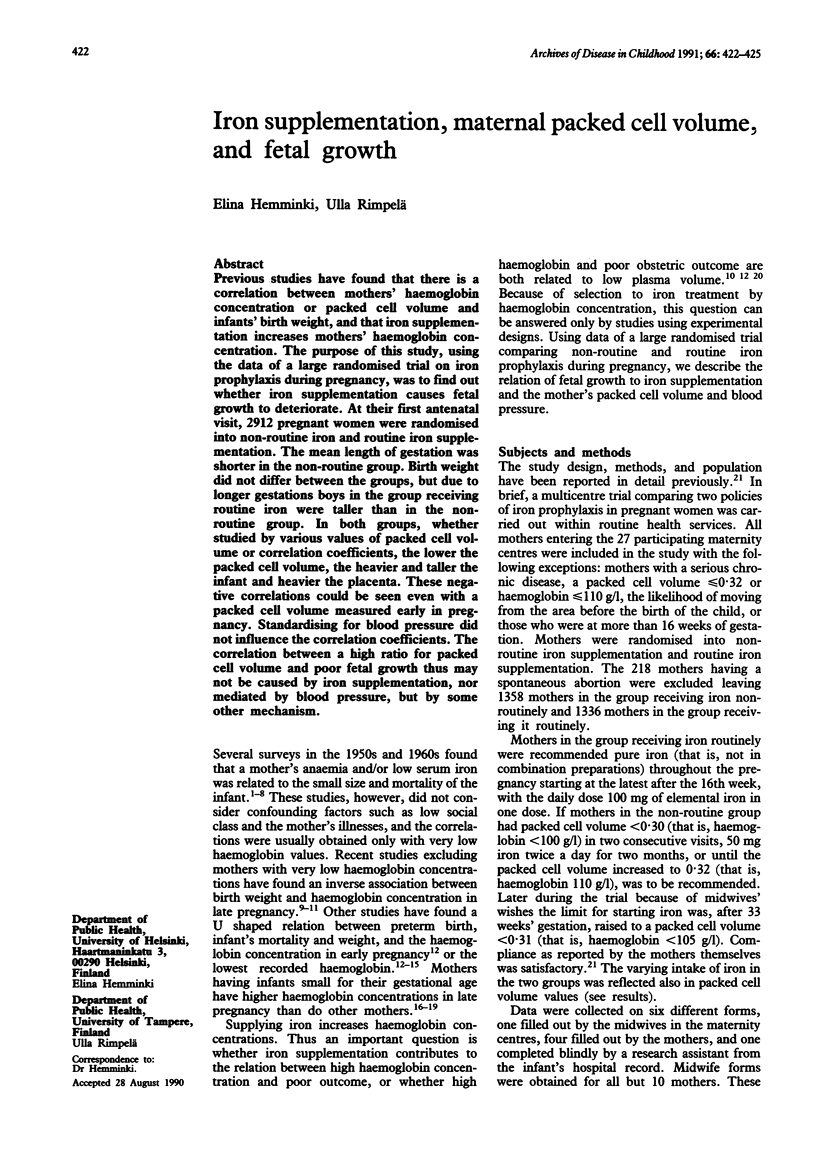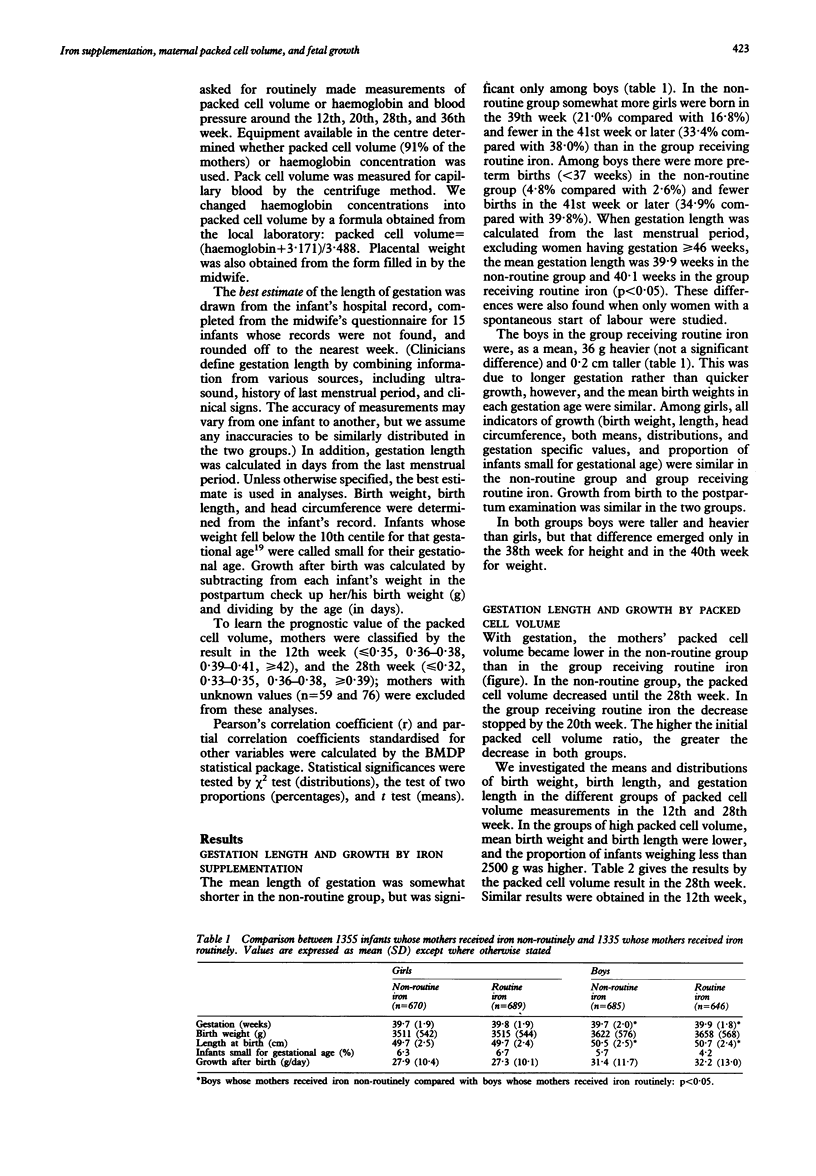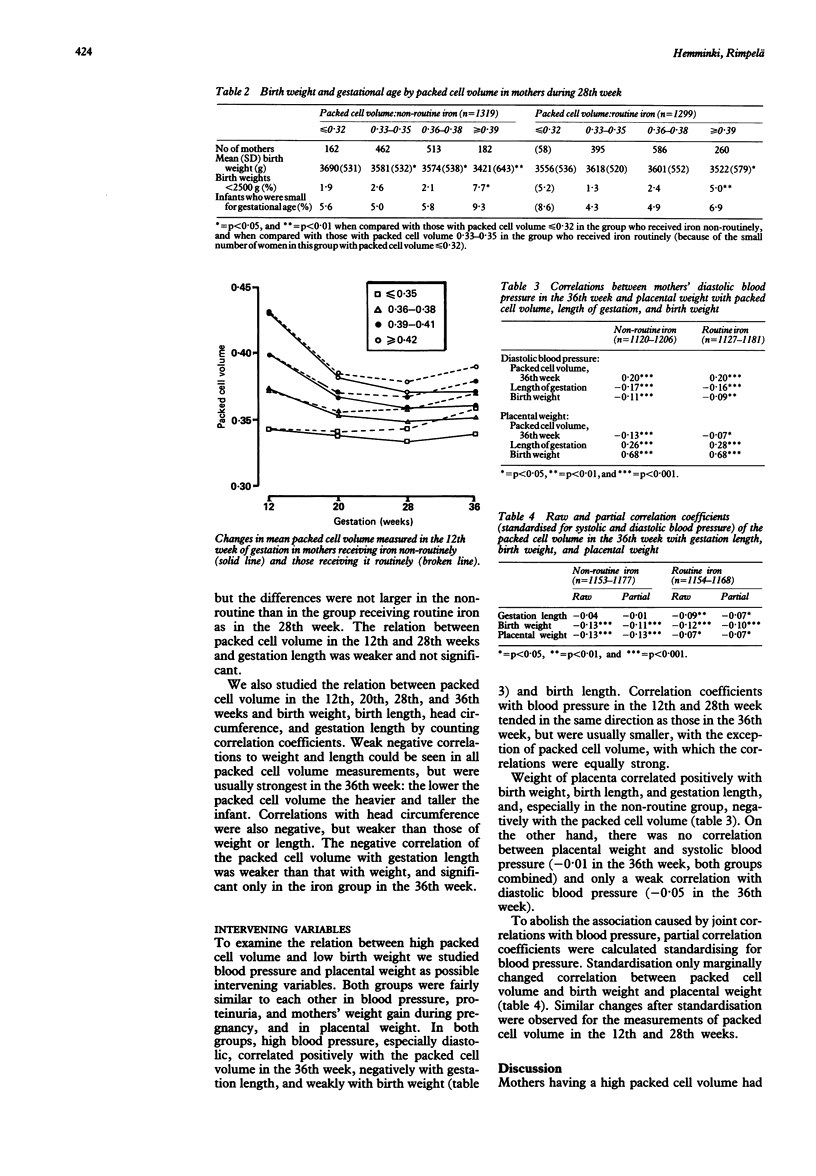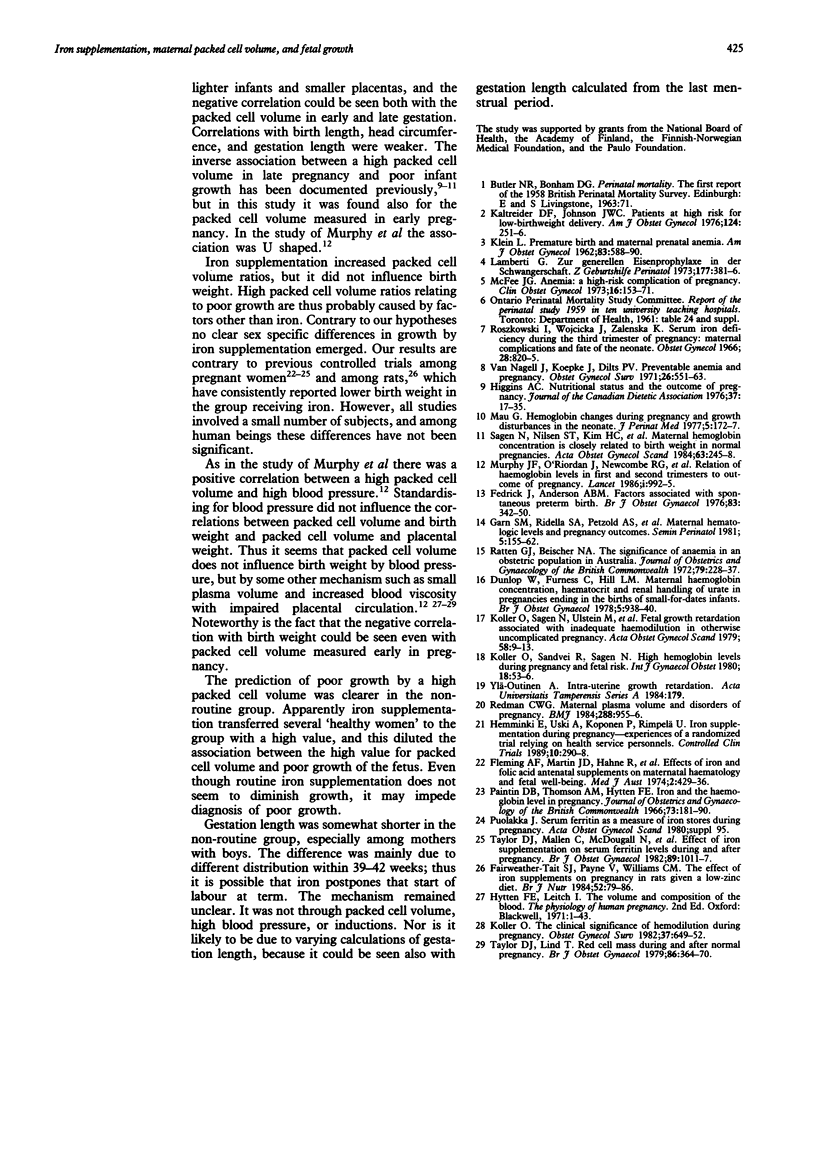Abstract
Previous studies have found that there is a correlation between mothers' haemoglobin concentration or packed cell volume and infants' birth weight, and that iron supplementation increases mothers' haemoglobin concentration. The purpose of this study, using the data of a large randomised trial on iron prophylaxis during pregnancy, was to find out whether iron supplementation causes fetal growth to deteriorate. At their first antenatal visit, 2912 pregnant women were randomised into non-routine iron and routine iron supplementation. The mean length of gestation was shorter in the non-routine group. Birth weight did not differ between the groups, but due to longer gestations boys in the group receiving routine iron were taller than in the non-routine group. In both groups, whether studied by various values of packed cell volume or correlation coefficients, the lower the packed cell volume, the heavier and taller the infant and heavier the placenta. These negative correlations could be seen even with a packed cell volume measured early in pregnancy. Standardising for blood pressure did not influence the correlation coefficients. The correlation between a high ratio for packed cell volume and poor fetal growth thus may not be caused by iron supplementation, nor mediated by blood pressure, but by some other mechanism.
Full text
PDF



Selected References
These references are in PubMed. This may not be the complete list of references from this article.
- Dunlop W., Furness C., Hill L. M. Maternal haemoglobin concentration, haematocrit and renal handling of urate in pregnancies ending in the births of small-for-dates infants. Br J Obstet Gynaecol. 1978 Dec;85(12):938–940. doi: 10.1111/j.1471-0528.1978.tb15857.x. [DOI] [PubMed] [Google Scholar]
- Fairweather-Tait S. J., Payne V., Williams C. M. The effect of iron supplements on pregnancy in rats given a low-zinc diet. Br J Nutr. 1984 Jul;52(1):79–86. doi: 10.1079/bjn19840073. [DOI] [PubMed] [Google Scholar]
- Fedrick J., Anderson A. B. Factors associated with spontaneous pre-term birth. Br J Obstet Gynaecol. 1976 May;83(5):342–350. doi: 10.1111/j.1471-0528.1976.tb00840.x. [DOI] [PubMed] [Google Scholar]
- Fleming A. F., Martin J. D., Hahnel R., Westlake A. J. Effects of iron and folic acid antenatal supplements on maternal haematology and fetal wellbeing. Med J Aust. 1974 Sep 21;2(12):429–436. doi: 10.5694/j.1326-5377.1974.tb70897.x. [DOI] [PubMed] [Google Scholar]
- Garn S. M., Ridella S. A., Petzold A. S., Falkner F. Maternal hematologic levels and pregnancy outcomes. Semin Perinatol. 1981 Apr;5(2):155–162. [PubMed] [Google Scholar]
- Hemminki E., Uski A., Koponen P., Rimpelä U. Iron supplementation during pregnancy--experiences of a randomized trial relying on health service personnel. Control Clin Trials. 1989 Sep;10(3):290–298. doi: 10.1016/0197-2456(89)90069-x. [DOI] [PubMed] [Google Scholar]
- KLEIN L. Premature birth and maternal prenatal anemia. Am J Obstet Gynecol. 1962 Mar 1;83:588–590. doi: 10.1016/s0002-9378(16)35887-2. [DOI] [PubMed] [Google Scholar]
- Kaltreider D. F., Johnson J. W. Patients at high risk for low-birth-weight delivery. Am J Obstet Gynecol. 1976 Feb 1;124(3):251–256. doi: 10.1016/0002-9378(76)90152-6. [DOI] [PubMed] [Google Scholar]
- Koller O., Sagen N., Ulstein M., Vaula D. Fetal growth retardation associated with inadequate haemodilution in otherwise uncomplicated pregnancy. Acta Obstet Gynecol Scand. 1979;58(1):9–13. doi: 10.3109/00016347909154904. [DOI] [PubMed] [Google Scholar]
- Koller O., Sandvei R., Sagen N. High hemoglobin levels during pregnancy and fetal risk. Int J Gynaecol Obstet. 1980 Jul-Aug;18(1):53–56. doi: 10.1002/j.1879-3479.1980.tb00241.x. [DOI] [PubMed] [Google Scholar]
- Lamberti G. Zur generellen Eisenprophylaxe in der Schwangerschaft. Z Geburtshilfe Perinatol. 1973 Dec;177(6):381–386. [PubMed] [Google Scholar]
- Mau G. Hemoglobin changes during pregnancy and growth disturbances in the neonate. J Perinat Med. 1977;5(4):172–177. doi: 10.1515/jpme.1977.5.4.172. [DOI] [PubMed] [Google Scholar]
- McFee J. G. Anemia: a high-risk complication of pregnancy. Clin Obstet Gynecol. 1973 Mar;16(1):153–171. doi: 10.1097/00003081-197303000-00009. [DOI] [PubMed] [Google Scholar]
- Murphy J. F., O'Riordan J., Newcombe R. G., Coles E. C., Pearson J. F. Relation of haemoglobin levels in first and second trimesters to outcome of pregnancy. Lancet. 1986 May 3;1(8488):992–995. doi: 10.1016/s0140-6736(86)91269-9. [DOI] [PubMed] [Google Scholar]
- Ratten G. J., Beischer N. A. The significance of anemia in an obstetric population in Australia. J Obstet Gynaecol Br Commonw. 1972 Mar;79(3):228–237. doi: 10.1111/j.1471-0528.1972.tb15789.x. [DOI] [PubMed] [Google Scholar]
- Redman C. W. Maternal plasma volume and disorders of pregnancy. Br Med J (Clin Res Ed) 1984 Mar 31;288(6422):955–956. doi: 10.1136/bmj.288.6422.955. [DOI] [PMC free article] [PubMed] [Google Scholar]
- Roszkowski I., Wojcicka J., Zaleska K. Serum iron deficiency during the third trimester of pregnancy: maternal complications and fate of the neonate. Obstet Gynecol. 1966 Dec;28(6):820–825. [PubMed] [Google Scholar]
- Sagen N., Nilsen S. T., Kim H. C., Bergsjø P., Koller O. Maternal hemoglobin concentration is closely related to birth weight in normal pregnancies. Acta Obstet Gynecol Scand. 1984;63(3):245–248. doi: 10.3109/00016348409155506. [DOI] [PubMed] [Google Scholar]
- Taylor D. J., Lind T. Red cell mass during and after normal pregnancy. Br J Obstet Gynaecol. 1979 May;86(5):364–370. doi: 10.1111/j.1471-0528.1979.tb10611.x. [DOI] [PubMed] [Google Scholar]
- Taylor D. J., Mallen C., McDougall N., Lind T. Effect of iron supplementation on serum ferritin levels during and after pregnancy. Br J Obstet Gynaecol. 1982 Dec;89(12):1011–1017. doi: 10.1111/j.1471-0528.1982.tb04656.x. [DOI] [PubMed] [Google Scholar]
- VanNagell J., Koepke J., Dilts P. V., Jr Preventable anemia and pregnancy. Obstet Gynecol Surv. 1971 Aug;26(8):551–563. [PubMed] [Google Scholar]


